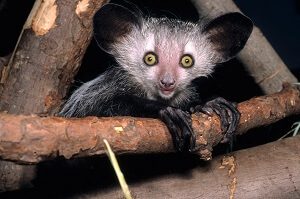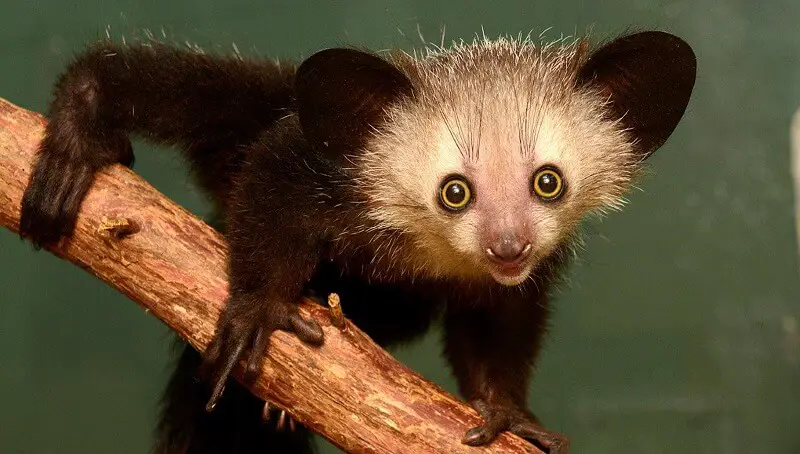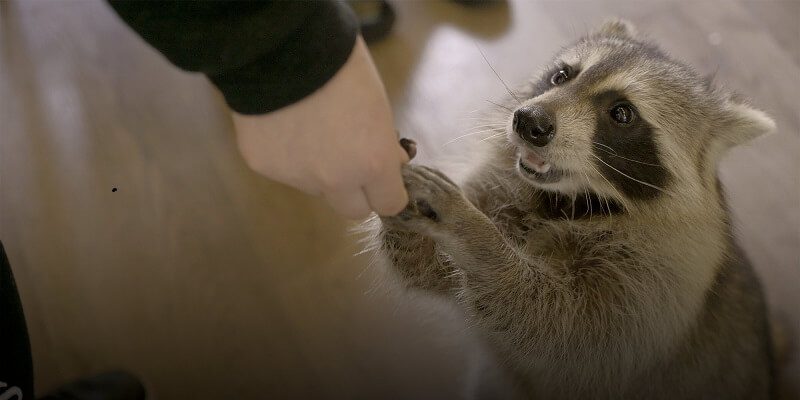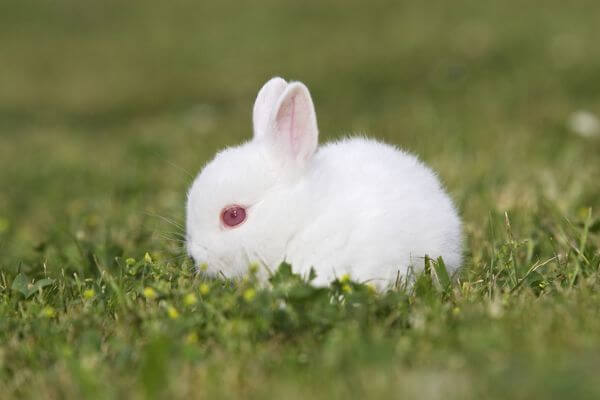- Area: Madagascar
- Habitat: Dense tropical forests
- Food: Omnivore
- Size: 30cm – 40cm
- Weight: 2 – 3 kg
- Speed: 32kph (20mph)
- Colors: Dark brown, black
- Litter: 1 offspring
- Predators: Fossa, birds of prey
- Behavior: Solitary
- Average span life: 20 years
- Special features: He has a longer finger
What is Aye Aye and where does its name come from?
Aye aye, Daubentonia madagascariensis, is a lemur belonging to the genus Daubentoniidae, the order Primates. The native of Madagascar is the size of a cat. His genre was named after the French naturalist Louis-Jean-Marie Daubenton by his student Etienne Geoffroy Saint-Hilaire in 1795. Another French naturalist named Pierre Sonnerat was the first to use the name, Aye Aye.
The closest relatives of aye aye are monkeys and chimps. Unfortunately, this animal is often hunted by superstitious locals because it is believed to be a demon or an animal that brings bad luck. It is now an endangered animal. The locals’ overhunt and destruction of the habitat is a vital danger to aye aye. The people of Malaysia considered it a symbol of evil.
The exact meaning of the name is no longer known, but aye aye is supposed to mean a warning of the presence of the animal. Some say it’s bad luck to come across such an animal, and it’s often sacrificed to drive away evil spirits.
Although the inhabitants of Madagascar considered it extinct in 1961, six specimens were found. More recent research has confirmed that there are more specimens on the island than previously thought, but the species is still in danger. In 2005, there were only a few dozen specimens.
It is the largest representative of the nocturnal primates. Currently, 50 individuals can be seen in various zoos.
What does an Aye aye feed on? What is its special trait?
As ugly as it is, it is stranger when it comes to its eating behavior. The Aye aye uses its long, thin finger to detect insects. He slowly knocks into the bark of the trees and pecks its ears to detect insects and larvae inside the trees.
You might also like my articles with facts about the Capybara, Proboscis Monkey, or Binturong.
They use echolocation to locate prey. When they detect a sound or a movement, they break the bark of the trees with their teeth and use the same finger to grab the prey. They have such a high dexterity that they manage to grab up to three larvae per second.
Their diet includes fruits too, the coconut being the one they prefer the most. That long, thin finger is also used to reach the core of the coconut. They also feed on seeds and nectar, being classified as omnivores.
They go out looking for food 30-180 minutes after the sun sets. 80% of the night is spent searching for food. The aye aye travels up to 4km per night.
Although it is considered a lonely and not too social animal, it still gathers in groups to look for food.
What does the Aye aye look like?
The Aye aye is a 2 kg animal with large ears, bulging eyes, and sharp teeth. The female has almost the same weight as the male. The difference is too small for the bare eye to notice any gender dimorphism. It has a length of 30-35cm, and with its tail, it measures up to 45-55cm.
The body is covered with a gray-colored, thorny coat, and the tail is thick. All its fingers are long and thin and end with claws, but a finger, in particular, is much longer and thinner. Adults differentiate themselves by the color of their darker eyes and the white hair around their necks.
Where can you find an aye aye?
Aye aye is a nocturnal animal. Although it spends most of its life at the top of the trees, it has been seen on the ground occasionally. Large eyes and bulbs give it good vision at night, and with the help of ears, they locate prey, which, as I said, is made mostly of insects. During the day, aye aye sleeps in spherical nests on a bed made of branches, twigs, and leaves.
The fairly large territory of an aye aye female, which it marks with smell, overlaps with the territory of a few males. It is known that the aye aye males share their territory and sometimes share their nests as well. It is tolerated quite a lot, except during mating.
The territory of the males, usually around 320 000 square meters, overlaps, but the territory of the females, around 80 000 square meters, does not overlap at all.
Breeding of Aye aye
 Aye aye males become aggressive during mating and fight for supremacy. Outside the mating period, individuals meet occasionally when looking for food. Being solitary animals, they spend little time with their family.
Aye aye males become aggressive during mating and fight for supremacy. Outside the mating period, individuals meet occasionally when looking for food. Being solitary animals, they spend little time with their family.
So, the males stay with the female and the cubs from the mating period until shortly after birth. The act of mating lasts an hour.
Mating can take place anytime, as they don’t have a mating season, and the pregnancy lasts 5 months. Females usually remain pregnant once every 2-3 years. Aye aye cubs spend the first 7 months of their life with their mother.
Aye aye life span
The longest-lived aye aye in captivity reached the age of 23. Life expectancy in the wild is unknown, and in captivity, the animal usually lives around 20 years.
Is The Aye-Aye Endangered?
The Aye-aye is an endangered animal, not only because of the destruction of its habitat but also because of superstitions. The people of Malaysia believed that Aye-aye was a symbol of evil.
The people of Madagascar thought that this animal had disappeared. It was rediscovered in 1961. Six specimens were transported to an island near Nosy Mangabe, near Maroantsetra, east of Madagascar. Recent research shows that these animals are more widespread than previously thought, but are still on the verge of extinction due to human superstition and ignorance.
Facts!
The name “aye-aye” may come from the sound that they make when they run into danger.
It locates its prey with the help of very good hearing and echolocation.
It is considered a demon that brings bad luck.
It is the only primate that feeds with the help of echolocation.
It is related to monkeys.




